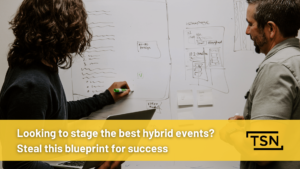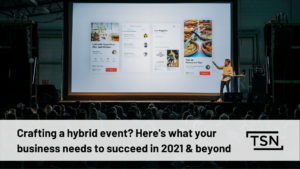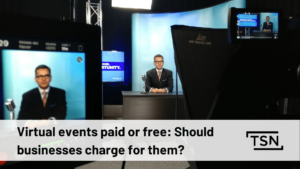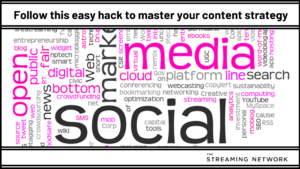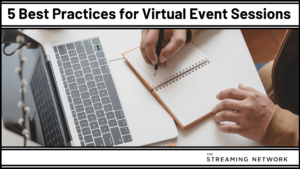Podcast: Play in new window | Download | Embed
Subscribe: Apple Podcasts | Google Podcasts | RSS
Last time, on “The Webinar: Lessons From The Front Line”, we discussed how to increase webinar viewership, using multiple methods including summit styles and “shark week” types of promotions.
In the latest episode, we’re going to continue to look into how to break down your webinar into multiple pieces of content throughout the year to continue to get new viewership, or “new blood”, into your sales funnel.
What we’re really trying to help you break down is how to get the most out of your webinars.
Tune in as we discuss the following topics:
- How long can you continue to use your webinar? This piece of content you develop can, and should, be used in multiple ways for an extended amount of time.
- Repurposing webinars into a simulated live webinar summit. Continue to offer you webinars in an “on-demand” setting where new viewers can find you when they want to.
- What’s “active on demand” mean, and how can you use it? You put a lot of effort into engagement during your live webinars, don’t have to throw it away for the on-demand version.
- Plus, a few simple ways to increase viewership. We’re giving you a few extra tips on how you can continue to use these top funnel content pieces.
The Complete Video Transcript:
Pete Vamos: Welcome to LFTF, the podcast about webinars and how they can make your B2B marketing strategy take flight. With me as usual, Matthew Ley, the President of Streaming Network. Welcome.
Matthew Ley: Thanks for having me, Pete.
Pete Vamos: You’re wearing the same sweater again.
Matthew Ley: I am wearing the same sweater again.
Pete Vamos: It’s uncanny.
Matthew Ley: And I believe that even though you said you had nailed the name of our show finally, I believe it’s changed again–
Pete Vamos: –Has it–?
Matthew Ley: –Even from the last one, yeah. So, just so you know.
Pete Vamos: LFTF.
Matthew Ley: Yeah. LFTF is the show and from there we don’t know. But yes, I am wearing the same sweater.
Pete Vamos: Listen, and the reason we’re back is we were cut off.
Matthew Ley: Yeah.
Pete Vamos: In our last show, we were talking about thought leadership webinars, and we were really getting into some interesting information about how to get the best stuff out of it, and the most out of your webinars. And I wanted to dig deeper into that, because it really is an important subject. And it is stuff that we sort of talk about again and again and again, but how to get the most out of your webinars is such a critical component of this–
Matthew Ley: –Right, so–
Pete Vamos: –And really the reason people are watching.
Matthew Ley: Right. And last time we did that topic because a critical part of anyone’s webinar program is driving more leads, right? And we spent a lot of time on the last show talking about the types of webinars we see perform the best. We talked about planning a program that allows for that binge-sort of effect, and we kind of got stopped short on how to utilize a piece of content, which a webinar is.
It’s not a moment in time, especially thought leadership, one, and it’s not something that only happens on this day with the archive going out to the people who didn’t show up. This is a content asset that can continue to work for you for a very long time, and should. And I think we did a service to that because a big way that you’re going to get more leads through your webinars is to ensure that you use that asset for at minimum the whole year. And if not, two years. A lot of–most of, thought leadership we see has a shelf life of about two years.
Pete Vamos: Right, right.
Matthew Ley: So.
Pete Vamos: So let’s keep going. Let’s keep talking about the subject. When you’re talking about webinars, you’re setting these things up. We got into, what I thought was a wonderful idea, this sort of Shark Week of webinars.
Matthew Ley: Right. Yeah.
Pete Vamos: But what we’re really talking about is ROI. What we’re really talking about is getting–
Matthew Ley: –Is getting more people.
Pete Vamos: Getting more people.
Matthew Ley: And getting more people to the same content so it’s more about your promotion and not about getting your thought leaders to talk more.
Pete Vamos: Yep.
Matthew Ley: And letting everyone know at that webinar all the good work that went into making that, the planning we talked about. If you’re bringing multiple people together for something, that it all makes sense, right? So you brought up Shark week, that’s one thing that I’ve got on my list, right? So, we talk about how you’ve got to respect the on demand and promote it. And there are ways of promoting it that can be innovative.
But first off, run your webinars more than once. Almost every platform now has a way, or you can jimmy rig it, to do what we call a simulated live. You run a webinar, and then you run it again. And you do command performance, you use it to fill your schedule later in the year. I mean, this is top of funnel stuff. There’s always new people looking into whatever topic you’re talking about, so it’s safe to promote that both in January and then again in June and then again in December. So run them more often.
Pete Vamos: Right.
Matthew Ley: The summit that we talked about last time, Shark Week for webinars that we decided we were going to do, that’s just a way of taking a bunch of these and running them all together, making them feel like a bigger deal and allow someone to binge consume them live, basically, driving a whole bunch of people back to learn everything they ever wanted to know about webinars but were afraid to ask during Shark Week. And they can come every day, and they can watch a webinar.
Pete Vamos: And this is repurposing stuff. This isn’t necessarily like for a–if you’re going to do a summit, you can bring in old stuff as well as fresh stuff.
Matthew Ley: I’m saying, in this case, like last time we talked about summits in general. In this case I’m saying, put four or five webinars together and call it a summit.
Pete Vamos: Right.
Matthew Ley: You’ve already done it. So repurposing the exact same webinar and doing it in a simulated live way, so you promote people to go to it. We’ve talked ad nauseum, because we do it, about repurposing the content from within a webinar. In this case, I’m just suggesting that you need to run your webinars more than once. Run the same webinar monthly, weekly, quarterly, I don’t know, in your Shark Week. But keep running those, because the more times you run them, you’ll probably get less and less viewers every time you run it, but they’re adding to the initial viewership count you had.
Pete Vamos: Right.
Matthew Ley: And the problem that the marketer said to us that they had is they wanted to get more people through their webinar program.
Pete Vamos: Right. One of the things that I think, you’ve probably had this question is, the big part of these sorts of webinars is the engagement is having audiences being able to polls and ask questions. When you’re doing it an on demand, how does that work?
Matthew Ley: So, simulated live and on demand in a lot of products don’t have what we call an active on demand. Simulated live I think always would, but on demand doesn’t. And so in my mind, to make best use of these strategies, you need to find a product that has what we call an active on demand. So we’re not the only one to have this, there’s lots. But active on demand means that all of the work you did in planning the engagement side of your live event, still work with the on demand version, your polls, your surveys, your downloads, and your reporting.
Embedded in that question was another question. What about the questions that come in? How are you going to answer those? You’re worried that you’re not going to be able to get those answered to the people. Well, the answer to what to do with that is dependent on the sheer, I guess, volume of your program in general. But in most cases, webinars get a very low number of people asking questions.
And so when we do these sorts of things, we’ve not done our Shark Week yet, but when we do our rebroadcast consistently, we don’t even man it. Someone watches it, and they respond to tech questions only. All the other questions get funneled through to me as the speaker or sales. And we respond personally in an attempt to drive a meeting out of them.
Pete Vamos: Right.
Matthew Ley: And I think that most people, if they’re honest with themselves, and they’re here asking this question, aren’t running programs that get a lot of–so many questions that that’s not feasible, they need to be there. People, as much as you think, they go there to get their questions answered, they don’t. They go there for the content that you’re providing and the information that you’re giving them.
Pete Vamos: But you can still generate the same kinds of lead scores and things like that and all that good stuff.
Matthew Ley: With an active on demand, you can generate all the same things as live as on demand. The benchmarks indicate that we’re well above a half an hour view time when on demand, 40 something minutes this year, it’s going up. More people are consuming on-demand content than live. You can, should, and will do that in the on demand.
But let’s talk about on demand, because, we’ve been saying for the past two, three years, you need to respect on demand. And it’s shocking to me the number of people who do a webinar and then with the on-demand, they shelve it somewhere, or they aggregate it, maybe they put it somewhere. But it’s like, that’s it, it happened, and now they’re on to the next one. When really, once again, it’s this great content asset.
And part of it’s because they’re on platforms where they can’t measure the lead score that well, but part of it’s just because in general, they’ve always built for the live days, like a live event. You get all the bums in seats, you shake hands, and you go and you count your ROI afterwards.
But, promoting on demand now with this new era, and it’s really there of the I want it now era, the Netflix era, the like–I used to be frustrated when I couldn’t find a great market link to get a show that I wanted. Now, if I can’t buy it or get it on one of the four subscriptions I have and services I use, I’m annoyed. How the heck could I not get this right now? So you want to fuel that and make it very easy for people to get your content when they want it. So this comes down to aggregating your webinar content.
And so we actually, on 24, created a product called Engagement Hub which is simply an easy way for people to aggregate, categorize, search, and aggregate content, because they were finding that a lot of webinars were not making it to that resources page or whatever because someone had to put it in there or whatever it might be. So they created this hub. And everyone who deploys it immediately starts talking about higher numbers through their program.
Those numbers are the live numbers–I’m sorry, the on-demand numbers, not the live numbers, right? Their live cadence is the same. So you want to find a way of aggregating it and pulling it together. There’s a ton of products out there that can do it. We have one, there’s a bunch, actually, Canada is a leader in this idea of providing content experiences. There’s a bunch of local guys that do it or just getting it up on your website, but you want to make that doable.
And then what I’m seeing work really well for these as well is, your thought leadership are–what is it? It’s best practices, right? It’s helpful for your customers, but it’s also helpful–sorry, for your prospects to get them in, but it’s helpful for your customers, it’s helpful for a lot of people. You might sell to one person in an organization and there’s three or four users or five or six other people that have to consume. This stuff is beneficial.
So I say use it in more places. Embed it in your knowledge center. Embed it in your internal culture, so your team can learn how to use it so when they get a question from a customer, prospect, or otherwise, they can say, “I’ve got the answer for you. It’s in this webinar that our president did last week.” So you want to keep that on-demand together, and you want to promote it.
The next stage in this, from a thought leadership–or from an on-demand, is this idea around–sorry, targeted content experiences.
Pete Vamos: Right.
Matthew Ley: So, usually this is done in the idea of like ABM strategies. But within an enterprise buyer, you’ve got your C-level, your manager, director, whatever it might be. And you’ve got the person, the doer, the user, the evaluator, the team who participate in your webinars and are usually the ones that spend the most time. So if you’re looking at attacking a company, attacking–if you’re looking at marketing to, promoting to, and selling to a large enterprise organization, you’re employing ABM strategies, webinars are part of that.
Publish those webinars within whatever ABM platform you’re using, whatever idea you’re using to get in front of these people, and make sure that there is that long format option within there as well. So, on demand is…it’s a disservice to leave it. It’s a disservice to–think about is as, what you were talking about this week and never talking about it again.
Pete Vamos: I think one of the things I find interesting about on demand is, there’s always that big moment. You’ve got–you’ve brought people in with a lot of knowledge. When you’re going in, you can promote the fact that this person is coming in.
Matthew Ley: That’s right.
Pete Vamos: But, you don’t know necessarily what they’re going to say. On demand, you get a chance to revisit that thing and say, “Check this out,” this a-ha moment, and you can actually use that as a promotional vehicle.
Matthew Ley: It’s so much easier to promote after the fact, right?
Pete Vamos: Yeah.
Matthew Ley: Like, I remember a huge mistake we made early on was, we were doing a webinar with a third party. And they had promoted it, very well I thought, I liked it, but maybe it was because they called me Webinar Expert Matt Ley, right? But it was fun, I loved it. So we took the creative and we had to go out to our–I sent it out to our base as well. Well, our base didn’t like–I guess didn’t respond quite as well as with me being called the Super Webinar Expert or whatever, it was their base that responded better.
So on demand, we flipped it up, we changed it, and it was a really–we just talked about the content itself, because our audience doesn’t care that I’m a webinar expert. Our audience, or our prospects are looking for answers to their problems, so we rephrased it into the answers to the problems that we were dealing with which was mapping content of the buyer’s journey or something, and it performed way better. And you’re right, you can learn so much on that.
But one other thing before you move on is, it dawned on me, it’s on my list too is the partner idea. So we’re all starving for content, right? There’s our–not starving, but we’d all like to have more good content. Your thought leadership is nothing if not that. So you’ve got partners who are in your space and you guys work collaboratively together. You may have resellers or referral partners, or there may be associations that you’re involved with, or publications that you’re involved with who are looking for more content. And your webinar could be offered to them as that piece of content.
So, when we do some of our big piece webinars, like the big idea webinars like ROI or engagement, is we go out to all of our resellers and offer them to reskin it, The Streaming Network, with, and have them promote it to their base the exact same webinar, simulated live, same premise is on that. So you’d be surprise when you start, if you do a few reach outs, that sort of thing, about how many people would be open to just taking your content and repurposing it that way, which gets more legs, gets more leads, all of that fun stuff.
Pete Vamos: And it gives you the chance, I guess, to go in, clean things up, tighten things up as well, and like you say, even cater to a completely different idea.
Matthew Ley: Well that would be another webinar and there’s ways of doing that. So, repurposing of content in that generation–
Pete Vamos: –Stay tuned–.
Matthew Ley: –Is a totally different thing, right? So this is simple an easy–I look at this, there’s an asymmetrical approach to hitting your KPIs in webinars that I’m only seeing in the very large organizations. The standard organization is symmetrical. We will run 12 webinars; we will hope to gain 5,000 new active leads through our program. We will do it in this cadence, this is what we’ll do on demand.
But what the larger organizations are doing are looking at, we have all these webinars, and we have these KPIs. So, we’re not there, what do we need to do? Well, let’s grab these five webinars, let’s run them again. Let’s get them out to this–it really performed well over here, let’s get more over there. Let’s do an on demand push, whatever it might be, and they’re just continuously trying to get more people, the right people, through this webinar program.
Pete Vamos: Right.
Matthew Ley: So, although, yeah, you can tweak, augment, and change and improve, and do that, which you probably will do anyways, these are strategies for getting the most out of that single webinar without touching it again, except maybe re-promoting it or whatever.
Pete Vamos: Right. Okay. Anything else? Anything else we want to cover on this in specific?
Matthew Ley: I’ve got a couple other simple things that I don’t know that everyone’s doing, but we think our sales reps pay attention but they don’t. I know mine don’t tune into this because they hear me yap all the time and they don’t necessarily know what pieces are in all of your content. So if you take the time to explain to them who the content’s for, why it’s valuable, they can use it in their various follow ups as well, right?
So most of our sales reps at the enterprise level are dropping in on prospects and ensuring they’re keeping in touch. And one thing to do is leaving them with a piece of content, the webinar could be a good piece of content depending on who that buyer is to say, “Hey, we just ran this webinar, it’s great.” They need to know what the webinar is about, they know why their persons should be able to view it, and so giving it to them is a good thing as well as embedding it in BDR strategies and the like.
We do thought leadership around ideas that our customers are interested in, and oftentimes, our frontline support folks are asked these questions, right? So if your CF is asked a question like, how do you–in our case, maybe, how do you get the most people to your webinar program, right? Well, they’re going to be like, they’re going to dealing with the semantics of utilizing remainder emails and following–like the simple, more basic stuff because their platform support, if they get that question. They’re not us, right?
And so, if you get these types of pieces of content into their hands, they can not only provide the answer from a product perspective, but they can provide them an answer that can really help this person drive more viewership or engage back with us for more help, even if we’re not selling them anything. So, you get these things into everyone hands. The beauty of it is, the more people that have it, the more options there are to share with new people, and the more new blood you will get sort of through your pipeline.
Pete Vamos: Which is ultimately the goal.
Matthew Ley: Which is ultimately the goal. Last time, last one–
Pete Vamos: –Yep–.
Matthew Ley: –Is get it to your social media team. You need a lot of posts on a lot of different platforms, on your most engaged platforms, people will side because they are engaged with you, they respect you, hey, that’s a webinar I haven’t seen, I’m interested. They may go through that way instead of through another way.
Pete Vamos: Right.
Matthew Ley: So there’s like 17 doors to get through this webinar, we want to make sure that everyone has those doors, and get it out there. And I know it goes against a lot of what social is about, but we are seeing high levels of registrations coming through social. Usually, it’s paid social, but we know it works. So do a Webinar Wednesday, whether or not you have a webinar, and promote your thought leadership there. And that will again, give you a boost, which is what we’re looking for, and more people through our programs.
Pete Vamos: Then alternately, I think as well, if you have a third party thought leader coming in, let him or her know, they can promote it again, right, they probably promoted it the first time. Let them know we’re running it again and get them out to their social networks.
Matthew Ley: Yeah. Once you start thinking about it, like, it’s an asset that has a built-in mechanism to measure leads and drive them, is yeah, get them out to as many spots as you can get them out to. And going back to our last one where we talk about planning a program where you have your thought leadership sitting up here and you know what it is, it shouldn’t muddy any water, right? It’s that evergreen content that’s good for your buyer at any point in time and you should be able to talk about it on January 1st and December 31st without there being any real issues.
Pete Vamos: Right.
Matthew Ley: So.
Pete Vamos: Good, good. Alright. Well, that’s another episode in the can. Matthew, thank you very much. Once again, great insights.
Matthew Ley: Thanks, Pete.
Pete Vamos: Don’t forget to share, don’t forget to drop us a note. We’re always eager to hear what audience members have to say. Until next time, see you again.

